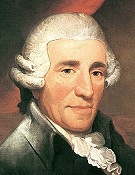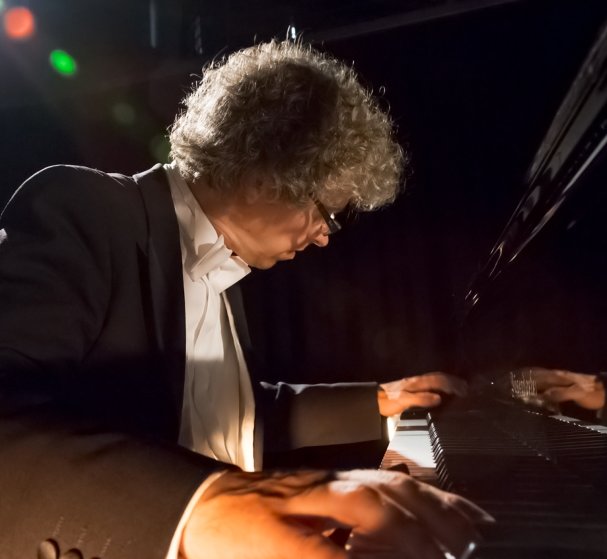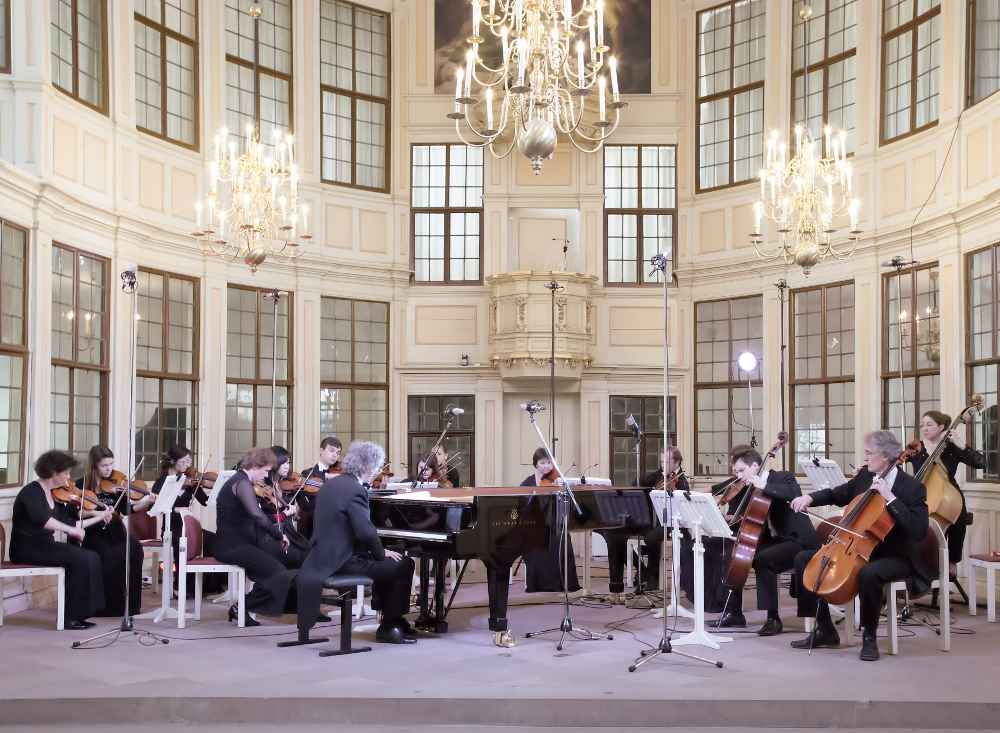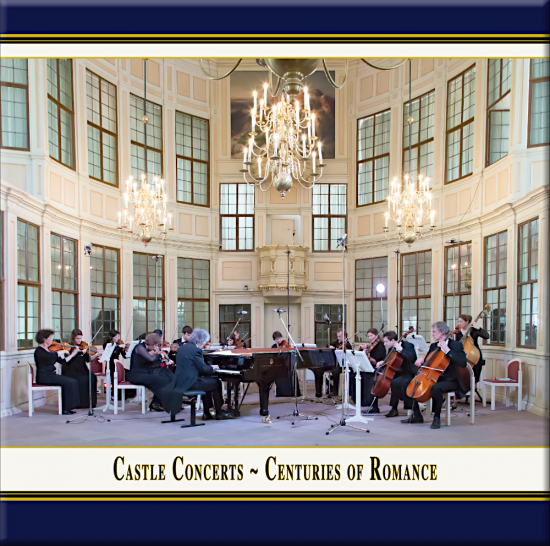Castle Concerts · Centuries of Romance
Centuries of Romance
Franz Vorraber (Piano & Conducting)
and the Castle Concerts Orchestra plays:
Joseph Haydn (1732-1809):
Concerto No. 4 in G Major for Piano & String Orchestra, Hob. XVIII:4
Franz Vorraber (*1962):
"Concerto Classico" for Piano & String Orchestra, Op. 37
World Premiere Recording
Frédéric Chopin (1810-1849):
Piano Concerto No. 1 in E Minor, Op. 11
A live recording from Bad Homburg Castle in Germany
HD Recording · DDD · Duration: c. 84 Minutes


C
astles and palaces have always inspired our imagination. They were and still are places of flourishing music culture, because they stimulate noble thoughts and deep feelings. Their tales and legends open our hearts and minds for romance in any sense. Standing in a castle one realises that romanticism embraces much more than the period so named. The works from different centuries and from multiple musical genres presented in our Castle Concerts series testify to this with the incomparable spirit of their interpretation.
With this release we give these thoughts a stage. We invited Franz Vorraber in his capacity as a pianist, composer and romanticist to plan and, eventually, to realize the present production in the historic castle of Bad Homburg (Germany). Franz built a beautiful concertant bridge from the 18th century to his specially created contemporary composition, and arranged it for piano and string orchestra explicitly according to our visions. The world premiere is being performed by the composer as both soloist and conductor with an orchestra carefully selected by himself - the result is stunning. But just lean back and listen for yourself...
Volker Northoff

P
apa Haydn - nothing of the sort! The great musician always knew how to entertain people without using cheep templates filled with gaudy timbres or highly dramatic gestures. For him, joie de vivre is admissible, even desirable. Behind this rhythmic vitality and all the gestures, the master distinguishes and seduces people to superior thoughts, too. Little is known about the creation of the piano concerto in G major. Guaranteed is just a date of performance on April 28th, 1784 at the Concert spirituel in Paris with the blind Viennese pianist Maria Theresia Paradis, whom also Mozart composed for. The importance of Haydn as author of concertos is still underestimated in the history of music. This particular concerto is composed for a string quartet only, without wind instruments. It comprises a typical, classically built work full of surprises and embellishments. This extent of humor and playfulness was rarely accomplished by later born composers.

Franz Vorraber recalls his memento this way. His "Concerto classico" op. 37 refers, as it can be seen from the title, back to the classical structure and the motives in terms of Haydn. As customary habit at the time, rhythmic set phrases and harmonic collocations of today have been used and processed. In the theme of the first movement this can easily be noticed. Thus, the formal arrangement between tutti and solo is obliged to the classical model. Some surprising twists, especially the intensifying rhythm throughout the piece, combine typical formula of the First Viennese School with contemporary elements.The simple theme of the second movement is enriched with complex harmonic turns. Due to the interjections of the piano, a harmonically opposed dialogue is created. The piano's harmonics, conducted with whole tones and additionally colored by the fifths of the strings, comes finally to a quiet ending. After a virtuosic opening, the third movement is designed concerto-grossostyle. The tutti is dominating the string orchestra. It is interrupted by the piano's soloist tours with a rather "groovy" basso continuo. The contrabass is taking the bass line in the middle part to calm the ensemble. After a wild cadence of the piano, the strings return with momentum and vividly end the work with copious virtuous piano figures.

Chopin loves singing and as a singing poet of the piano, he inveigles into the universe of dreams. Chopin composed the piano concerto in e minor at the age of 20 during spring and summer of 1830 in Warsaw. It emerged shortly after his concerto in f minor and belongs to the standard repertoire of concert literature. In fall 1830, Chopin left Warsaw to go to Paris. This work is based mainly on polish dancing rhythms; especially prominent is the Krakowiak in the last movement. Eventually, his work is characterized by its exceptional cantability. Chopin writes operas for the piano. He most likely performed this concerto himself in Warsaw in the same string casting as it can be heard here.
Franz Vorraber

F
ranz Vorraber is an internationally renowned pianist and composer. For example he repeatedly performed the complete solo oeuvre of Robert Schumann in cycles of twelve concertos and published it in a thirteen-part CD recording at Thorofon, receiving numerous international awards and honors. Being born in Graz/Austria, his studies have been shaped by the First Viennese School and the German School, and he graduated with a soloist diploma and unanimous decoration. Franz Vorraber was invited as soloist to internationally famous festivals as the Viennese Musiksommer, the piano festival Ruhr, the music festival Schleswig-Holstein, the Mozartfest Wuerzburg, the Mendelssohn Fest in Leipzig, the Klosterkonzerte Maulbronn, the Musiksommer of Chorin, the European Weeks of Passau, the Frankfurter Feste, the Festival Santander, the Schubertiade, the Rheingau music festival, the Hohenloher Kultursommer, the Bebersee festival et cetera. He worked with conductors like Dennis Russell Davies, Fabio Luisi, Alun Francis, Gabriel Feltz, Mar Tardue or Marcus Bosch. His repertoire of piano concertos includes 50 different concertos. Many of them were released on CD. His own works as a composer have been increasingly performed lately. There have been many premieres of pieces of chamber music at the Mendelssohn Fest at the Gewandhaus or at the Schumann Fest in Bonn in cooperation with the blowers of the Staatskapelle Berlin and musicians of the Gewandhaus Leipzig. A great success was the premiere of his first piano concerto at the Klosterkonzerte Maulbronn. Some works of piano were published by Thorofon and by K&K Verlagsanstalt, amongst them "Sentences of Love" in cooperation with the poet and writer Peter Haertling.

T
he Castle Concerts Orchestra has been individually assembled by Franz Vorraber due to this production to guarantee the best body of sound possible for the arrangements and compositions. We named the orchestra after our series "Castle Concerts", in which Framework this concerto was performed and recorded at Bad Homburg Castle.
Concert Master: Barbara Kummer-Buchberger (Frankfurt)
Violins: Barbara Kummer-Buchberger (Frankfurt), Yuri Uomizu (Wiesbaden), Corinna Freibott (Bad Bocklet), Yana Luzman (Würzburg), Hwoyeong Lee (Wiesbaden), Florian Bartl (Friedrichsdorf), Julia Muginstein (Würzburg), Paul Hartwein (Oberursel), Clara Holzapfel (Wiesbaden)
Violas: Hiltrud Hampe (Frankfurt), Konstantin Molodchinin (Würzburg), Ulrike Kruttschnitt (Würzburg)
Cellos: Bernhard Zapp (Bonn), Jan Ickert (Frankfurt)
Double Bass: Susan Lutz (Würzburg)
P
ublishing Authentic Classical Concerts entails for us capturing and recording outstanding performances and concerts for posterity. The performers, audience, opus and room enter into an intimate dialogue that in its form and expression, its atmosphere, is unique and unrepeatable. It is our aim, the philosophy of our house, to enable the listener to acutely experience every facet of this symbiosis, the intensity of the performance, so we record the concerts in direct 2-Track Stereo digital HD. The results are unparalleled interpretations of musical and literary works, simply - audiophile snapshots of permanent value. Flourishing culture, enthralling the audience and last but not least also you the listener, are the values we endeavor to document in our editions and series.
Music that is new, pieces worth listening to and well worth conserving, little treasures from the traditional and the avantgarde - music that is unimaginable anywhere else but in the hotbed of Europe - we capture these in our Castle Concerts Series of recordings in their original settings in cooperation with Volker Northoff.
The concert grand piano is incontestably the king of instruments. We could now wax lyrical about its incomparable dynamics and go into its ability to go from the tenderest of sounds in a soft minor key to the magnificent power of a fortissimo, or I could rhapsodise about its impressive size and elegance. But what makes this instrument really fascinating is its individuality, since each one is unique in itself - created by a master. A concert grand has a life all of its own that a virtuoso can really "get into" and hence bring the work of the composer to life. In our Grand Piano Masters Series, we get into the character and soul of the concert grand piano and experience, during the performance itself, the dialogue between the instrument, the virtuoso and the performance space.
Andreas Otto Grimminger & Josef-Stefan Kindler, K&K Verlagsanstalt
Joseph Haydn (1732-1809):
Concerto No. 4 in G Major for Piano & String Orchestra, Hob. XVIII:4
Cadences by Franz Vorraber
1. I. Allegro moderato [8:25]
2. II. Adagio [6:32]
3. III. Rondo. Presto [4:21]
Franz Vorraber (*1962):
"Concerto Classico" for Piano & String Orchestra, Op. 37
World Premiere Recording
4. I. Allegro [8:07]
5. II. Andante [8:17]
6. III. Allegro [6:22]
Frédéric Chopin (1810-1849):
Piano Concerto No. 1 in E Minor, Op. 11
Version for Piano & String Orchestra
7. I. Allegro maestoso [21:19]
8. II. Romanze. Larghetto [9:47]
9. III. Rondo. Vivace [10:21]
10. Applause [0:23]
Concert Grand Piano: Steinway & Sons D-274 (No. 597417)
A concert recording from Bad Homburg Castle in Germany, April 19, 2015,
recorded, released & created by Andreas Otto Grimminger & Josef-Stefan Kindler
in cooperation with Volker Northoff
Sound & Recording Engineer: Andreas Otto Grimminger
Production & Mastering: Andreas Otto Grimminger & Josef-Stefan Kindler
Photography, Artwork & Coverdesign: Josef-Stefan Kindler

Featured by Spotify
This release is featured in the editorial Spotify playlist of handpicked new classical Releases - August 2, 2019





Featured by Spotify
3. August 2019 - 11:08 — kuk-art.comhttps://open.spotify.com/playlist/37i9dQZF1DWV0gynK7G6pD